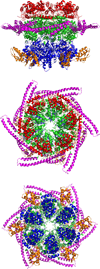Aggregate reactivation mediated by the Hsp100 chaperones
- PMID: 22306514
- PMCID: PMC3307897
- DOI: 10.1016/j.abb.2012.01.012
Aggregate reactivation mediated by the Hsp100 chaperones
Abstract
Hsp100 family of molecular chaperones shows a unique capability to resolubilize and reactivate aggregated proteins. The Hsp100-mediated protein disaggregation is linked to the activity of other chaperones from the Hsp70 and Hsp40 families. The best-studied members of the Hsp100 family are the bacterial ClpB and Hsp104 from yeast. Hsp100 chaperones are members of a large super-family of energy-driven conformational "machines" known as AAA+ ATPases. This review describes the current mechanistic model of the chaperone-induced protein disaggregation and explains how the structural architecture of Hsp100 supports disaggregation and how the co-chaperones may participate in the Hsp100-mediated reactions.
Copyright © 2012 Elsevier Inc. All rights reserved.
Figures


Similar articles
-
The ClpB/Hsp104 molecular chaperone-a protein disaggregating machine.J Struct Biol. 2004 Apr-May;146(1-2):99-105. doi: 10.1016/j.jsb.2003.11.016. J Struct Biol. 2004. PMID: 15037241 Review.
-
Hsp70 targets Hsp100 chaperones to substrates for protein disaggregation and prion fragmentation.J Cell Biol. 2012 Aug 6;198(3):387-404. doi: 10.1083/jcb.201201074. J Cell Biol. 2012. PMID: 22869599 Free PMC article.
-
The molecular chaperone Hsp104--a molecular machine for protein disaggregation.J Struct Biol. 2006 Oct;156(1):139-48. doi: 10.1016/j.jsb.2006.02.004. Epub 2006 Mar 6. J Struct Biol. 2006. PMID: 16563798 Review.
-
The molecular mechanism of Hsp100 chaperone inhibition by the prion curing agent guanidinium chloride.J Biol Chem. 2013 Mar 8;288(10):7065-76. doi: 10.1074/jbc.M112.432583. Epub 2013 Jan 22. J Biol Chem. 2013. PMID: 23341453 Free PMC article.
-
Successive and synergistic action of the Hsp70 and Hsp100 chaperones in protein disaggregation.J Biol Chem. 2004 Oct 22;279(43):44376-83. doi: 10.1074/jbc.M402405200. Epub 2004 Aug 9. J Biol Chem. 2004. PMID: 15302880
Cited by
-
Simple model systems reveal conserved mechanisms of Alzheimer's disease and related tauopathies.Mol Neurodegener. 2023 Nov 10;18(1):82. doi: 10.1186/s13024-023-00664-x. Mol Neurodegener. 2023. PMID: 37950311 Free PMC article. Review.
-
The huntingtin inclusion is a dynamic phase-separated compartment.Life Sci Alliance. 2019 Sep 16;2(5):e201900489. doi: 10.26508/lsa.201900489. Print 2019 Oct. Life Sci Alliance. 2019. PMID: 31527136 Free PMC article.
-
Substrate Discrimination by ClpB and Hsp104.Front Mol Biosci. 2017 May 29;4:36. doi: 10.3389/fmolb.2017.00036. eCollection 2017. Front Mol Biosci. 2017. PMID: 28611991 Free PMC article.
-
Cancers adapt to their mutational load by buffering protein misfolding stress.Elife. 2024 Nov 25;12:RP87301. doi: 10.7554/eLife.87301. Elife. 2024. PMID: 39585785 Free PMC article.
-
Host cell stress response as a predictor of COVID-19 infectivity and disease progression.Front Mol Biosci. 2022 Aug 11;9:938099. doi: 10.3389/fmolb.2022.938099. eCollection 2022. Front Mol Biosci. 2022. PMID: 36032680 Free PMC article. Review.
References
Publication types
MeSH terms
Substances
Grants and funding
LinkOut - more resources
Full Text Sources
Molecular Biology Databases

